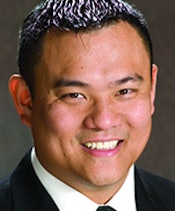
ANAHEIM, CA - Outcomes can be improved and patients can achieve systemic health benefits through the management of periodontal risk factors, according to a presentation by Jonathan S. Wong, DDS, on the opening day of the California Dental Association CDA Presents 2015 meeting.
In an April 30 presentation, Dr. Wong noted that the prevalence of periodontal disease has increased sharply in the past 15 years, with consequences for the general population and for dental practices.
"In 1999, a third of adults in the U.S. had some form of periodontal disease," he said. "In 2009, almost half, or 47.2%, of these adults had some form. Now this incidence is even higher."
“If you see a patient who has diabetes, they probably have periodontal disease.”
The incidence of periodontal disease increases with age, lower socioeconomic level, and non-Caucasian population, among other risk factors, he added.
"If you see a patient who has diabetes, they probably have periodontal disease," he said.
Although more general practitioners are performing periodontal procedures, he emphasized that treatment of this complex disease isn't linear or simple.
"I saw a study that reported that half of patients with deep pockets -- 5 mm or greater -- were placed on maintenance treatment alone," he said. "Every six months isn't often enough."
He noted that periodontal disease is complex, involving inflammation, bone loss, hygiene, bacterial infection, and more.
"We need to also acknowledge that there are acquired and genetic factors that influence a patient's susceptibility to infection," he said.
Dr. Wong advocated for a treatment approach that evaluates the "big picture."
 Jonathan S. Wong, DDS, of University of the Pacific School of Dentistry.
Jonathan S. Wong, DDS, of University of the Pacific School of Dentistry."You have to ask yourself, 'How am I managing this patient's disease?' " he said. "One treatment plan, one therapeutic approach won't work for every patient."
He recommended a comprehensive treatment approach that includes early recognition, an accurate diagnosis, frequent re-evaluation, and management of a patient's risk factors.
"We have to treat the chronic disease process," Dr. Wong said.
He also urged evaluation of the entire mouth, not just one or two teeth.
"If we treat the generalized condition rather than just a diseased area, we may be able to preserve a patient's teeth," he said.
Dr. Wong also noted that radiographic assessment is often inferior to examination by the practitioner.
"Radiographic assessment often underestimates the damage and the alveolar bone loss," he said, though a full-mouth series is often more diagnostic than panoramic radiographs.
Dr. Wong said he understands why general dentists perform periodontal procedures, and he wants to rebuild the relationship between general practitioners and periodontologists.
"When my father was practicing, he used to say everyone was pulling in the same direction," Dr. Wong said. "I'd like to see all of us get back to that."
Dr. Wong is an assistant clinical professor at University of the Pacific School of Dentistry and is in private practice in Ventura and Oxnard, CA.

















